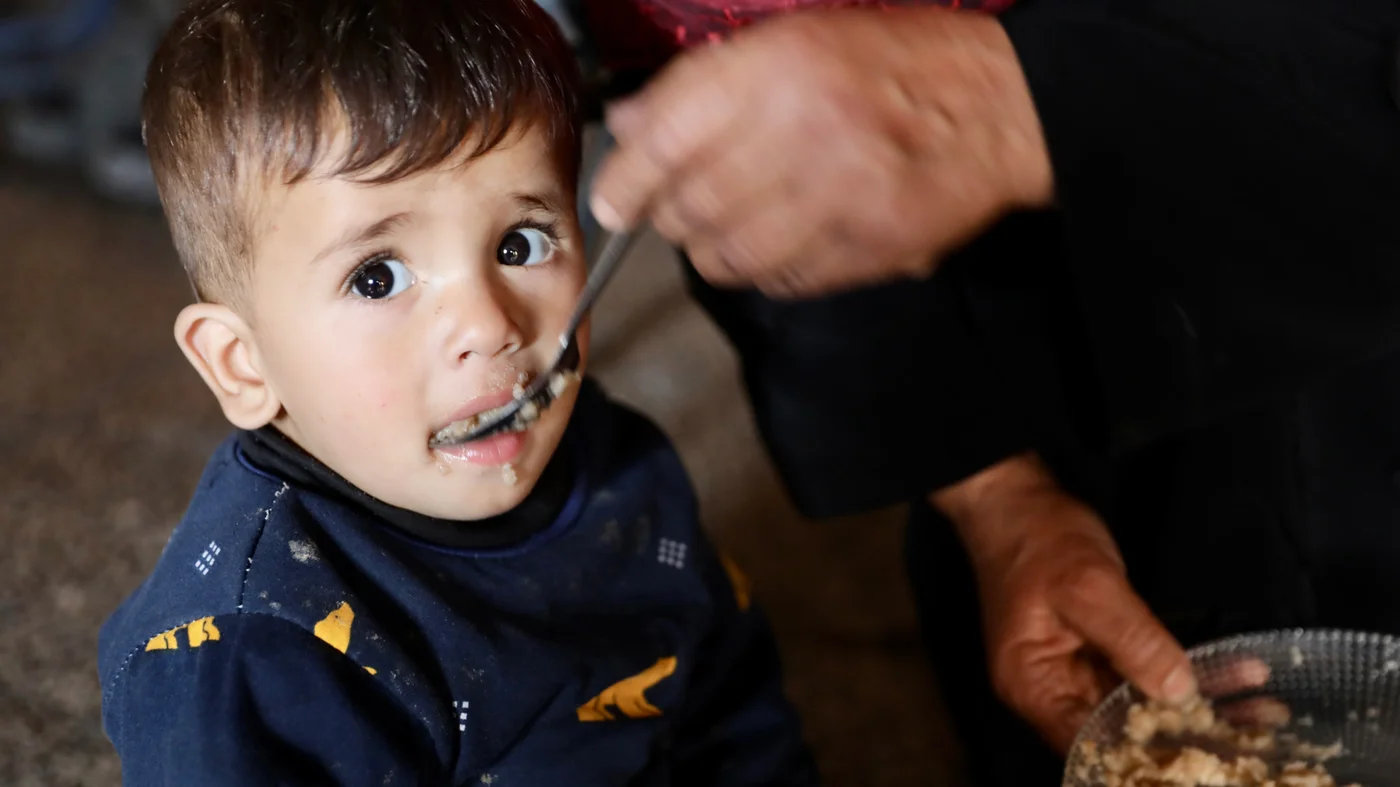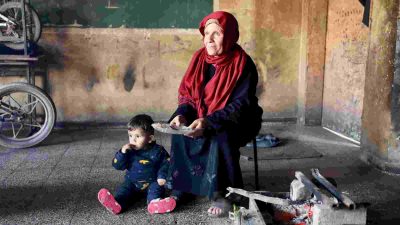
As the hunger “caused by man” gets worse under Israeli siege, Palestinian families feed their children with makeshift versions of traditional dishes amid extreme hunger
Beside a makeshift wood stove, in a classroom that served as a home last year, a Kamal Ubeid kindly feeds his one year old, Kareem.
The plate is simple: bread soaked in tea, but for the Palestinians in Gaza, it has become a salvation board in the midst of extreme scarcity.
Known locally as Fattah tea, the modest meal has long been associated with the darkest moments of Gaza, such as Israeli offensive and prolonged blocks.
Now, with rice, grains and canned food exhausted due to the total Israeli siege, it is all that remains for the Ubeid family to survive.
“I don’t remember exactly the first time I had a tea fattah, but I was about 14 years old during the early years of the 2008–2009 block and war,” Karem’s father Kamal Ubeid, 32, said in an interview with Middle East Eye.
“At that time, we had nothing to eat, so we survived with tea and the pieces of dry bread we could find.”
Kamal remembers how his mother prepared it for him and his brothers, especially when they cried hungry.
“To this day, she still does this, for us and my children,” he said.
“Nowadays, we depend more on him than ever, since we have no canned food. It’s Fattah or Manakish tea.”
Kamal Ubeid, 32, makes tea in its shelter in the city of Gaza | Mohammed Al-Hajjar/Mee
Since the beginning of the war in Gaza, Israel has closed the borders of the track and severely restricted the entry of goods, food, medicine and fuel.
But on March 2, it imposed a total blockade, completely blocking the entry of all vital supplies, including food, water and international aid.
At the same time, the Israeli forces have routinely opened fire against fishermen and Palestinian farmers who try to access what remains of the devastated food sources of the track, killing and hurting dozens.
The population of Gaza, approximately 2.3 million, was launched in what the UN and humanitarian organizations described as a “caused by man” hunger, which has already claimed the lives of dozens of civilians, especially children and the elderly.
War meals
A Kamal is used to listening to Israeli block ads. Whenever you hear that one is imminent, it begins to stock essential items – canned, grains, wheat flour – and especially large amounts of tea.
“In normal times, we like tea so much that we drink it day and night. But in short days, it becomes a source of nutrition when we feel hungry, a comfort when we are looking forward and even a replacement for coffee when we fight with abstinence,” a Kamal Ubeid told Mee.
“During the blockade north of Gaza, in the first year of this war, we used to boil tea seven or eight times a day. We had nothing more to eat or drink,” she recalled.
“When it was dark and the bombs shook the city, we gathered around the wood, we had tea and made Fattah tea for our children to distract us.”
Now, with the shortage of supplies, milk and babies formula were among the first essential items to disappear, especially after the UN and other humanitarian aid agencies announced that they were suspending distributions due to the exhausted warehouses.
Without childhood nutrition, families began to feed their young children with Fattah tea.
“This child is only one year old, a crucial phase of development, and needs vitamin -enriched milk to grow properly, especially when there is no meat, vegetables or fruits available,” said a Kamal.
“Still, we give him tea with bread. We know it’s harmful to a child of this age to consume tea or any kind of caffeine, but when she screams hungry, you get impossible choices: or let her starve or try to keep her alive, even if it affects your health.”
 A Kamal Ubeid knows that giving tea to grandson is not healthy, but there is no other option | Mohammed Al-Hajjar/Mee
A Kamal Ubeid knows that giving tea to grandson is not healthy, but there is no other option | Mohammed Al-Hajjar/Mee
According to the Integrated Food Security Phases (IPC) classification, about 2.1 million people in the Gaza range are expected to face high levels of acute food insecurity between May and September.
This includes almost 469,500 people who must undergo catastrophic food insecurity.
The current perspective marks a sharp deterioration compared to the IPC analysis in October 2024, signaling a dramatic climbing in what is already one of the most serious eating and nutritional crises in the world.
Until April, more than 65,000 children in Gaza were hospitalized with acute malnutrition, an estimated 1.1 million total that face hunger daily, according to the Gaza Government’s media office.
False dishes
For a Muhammed Nashwan, Tea Fattah is not just a way to feed your children.
It replaces the original Gaza Fattah, an worshiped dish traditionally made with bread soaked in broth or chicken and served with generous portions of meat and white rice.
It is usually prepared on Fridays, when families gather at home to mark the beginning of the weekend.
“Although there is a big difference between the two, I usually make a Fattah of tea for my children when they ask for traditional Fattah, but I only have water and bread to use,” she told Mee.
Other times, it simply boils water, adds a pinch of salt and pepper, soothes the bread in it and fits your children.
“Before the war, we used to do Fattah every Friday, and the main ingredient was always meat. But we haven’t seen meat for months, so we had to improvise, recreating our traditional Gaza dishes with what we found,” Náhwan explained.
“This dish is called ‘false fatah.’ In fact, we call ‘fake’ any dish we do without its main ingredients,” she said, laughing.
Another basic Friday meal is Makloubeh, a plate whose name means “upside down” in Arabic, referring to the way it is prepared and served, turning it out of the pan.
Usually contains layers of rice, meat (such as lamb, chicken or beef) and vegetables such as eggplant, cauliflower and potatoes.
 In the absence of meat, the traditional Gaza Fattah is transformed into bread soaked into tea for children | Mohammed Al-Hajjar/Mee
In the absence of meat, the traditional Gaza Fattah is transformed into bread soaked into tea for children | Mohammed Al-Hajjar/Mee
Even under siege and bombing, some families continued this Friday’s tradition, relying on the left-wing ingredients.
“During the war, we had none of Makloubeh’s main ingredients except rice and peppers,” Náhwan explained. “So we did what we called ‘fake makloubeh’ – made without the essential meat and vegetables.”
When Israel suspended the blockade briefly and partially during the January ceasefire, limited quantities of meat and vegetables were allowed, among other products.
It was then that Nashwan decided to prepare a suitable Makloubeh for his family – the first in almost a year.
My youngest son, seven, asked what I was cooking. When I said it was Makloubeh, he frowned and said, ‘I hope it is not fake this time.’
It may seem funny, but it’s painful. Our children yearn for a real meal, something that has a familiar smell and taste.
Originally published by Mee on 15/05/2025
By Maha Hussainina City of Gaza, Palestine occupied
Source: https://www.ocafezinho.com/2025/05/16/gaza-quando-os-pratos-da-cultura-viram-simbolos-da-fome/

